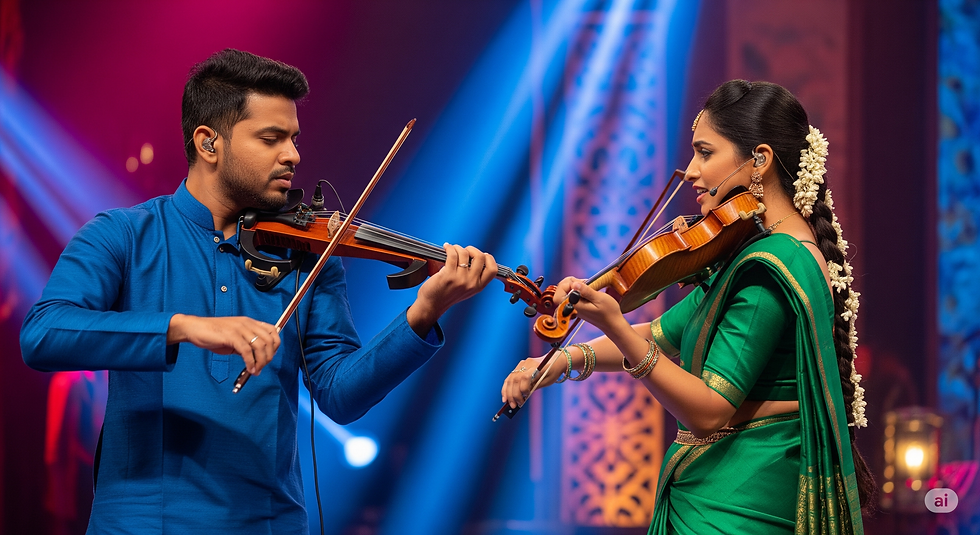"Rhythm in Strings: Mastering Laya for Carnatic Violin Brilliance"
- Sharanya naidu
- Sep 27, 2024
- 4 min read
Updated: Oct 16, 2024
In Carnatic music, laya (rhythm) is just as essential as raga (melody), and mastering it is crucial for any violinist. While the violin is primarily known for its melodic beauty, its rhythmic precision and improvisational flair add an exciting dynamic to performances. Understanding the role of rhythm in Carnatic violin not only deepens a musician's technical ability but also enhances their ability to engage and captivate an audience.
Why is Laya Important in Carnatic Music?
Laya is the backbone of Carnatic music. It provides a structured framework that guides the flow of a composition, giving performers the freedom to improvise while maintaining coherence. In a typical Carnatic concert, violinists often perform alongside a vocalist and percussionist (mridangam or kanjira), and the interplay of rhythmic patterns between these instruments is essential to creating a cohesive musical experience.
For a violinist, keeping pace with the tala (rhythmic cycle) is critical. Talas range from simple patterns like Adi Tala (8 beats) to complex structures like Khanda Chapu (5 beats). A Carnatic violinist must not only maintain these rhythmic cycles but also weave their improvisations around them. This balancing act demands a strong sense of timing and coordination.
Rhythmic Precision: The Foundation of Mastery

Rhythmic precision is vital in the initial stages of learning Carnatic violin. Beginners are trained to follow the mridangam or other percussion instruments closely, learning how to align their bowing patterns with the beat. For example, when playing kalpana swaras (improvised notes), the violinist needs to land on key points within the tala cycle, maintaining perfect synchrony with the percussion.
Advanced violinists go a step further by incorporating rhythmic intricacies in their playing. For instance, they might explore different gati bhedas (subdivisions of rhythm), moving between 3, 4, 5, 7, and 9 beats within a single tala. This demands not only mental agility but also the physical dexterity to control the bow with precision.
Improvisation: Laya as a Creative Playground
One of the most exciting aspects of Carnatic violin performances is the freedom of manodharma sangeetam—the art of improvisation. While the violinist must maintain rhythmic accuracy, they are also expected to bring their creative voice to the performance. This is especially true during sections like ragam tanam pallavi, where the violinist improvises intricate rhythmic patterns in sync with the tala.
In these moments, the violinist uses laya as a canvas for rhythmic exploration. They might choose to syncopate, stretch, or condense rhythmic patterns, all while adhering to the core structure of the tala. For example, a violinist could improvise by introducing a sequence of faster notes (called nadai variations) or by subtly shifting emphasis on different beats of the tala to create tension and release. These rhythmic variations showcase the violinist's technical skill and creativity, bringing a new dimension to the performance.
Key Exercises for Mastering Laya
Clapping the Tala: Before playing, practice clapping the tala cycle to internalize its rhythm. This develops an intuitive sense of timing that is crucial for improvisation.
Playing with Metronome: Use a metronome or an electronic talameter to practice playing swaras, varnam, or kritis at different tempos. This helps refine your precision.
Mridangam Accompaniment: Practicing with a mridangam accompaniment sharpens your ability to stay in sync with complex rhythmic patterns. If you don’t have access to a live mridangam, use apps that simulate the instrument.
Gati Bheda Exercises: Play a simple melody or scale, switching between different gatis (rhythmic subdivisions) to get comfortable moving in and out of different rhythmic groupings.
Improvising within the Tala: Practice improvising swaras, gamakas, or ragam phrases while keeping time. Start by aligning your improvisations with key beats and gradually experiment with more complex rhythmic variations.
The Beauty of Rhythmic Balance
Mastering laya is not just about technical proficiency—it’s about creating a dynamic balance between melody and rhythm. The violinist’s role in a Carnatic performance is unique: they must blend seamlessly with the percussionist and vocalist while also standing out during solo sections. Rhythm, when skillfully handled, adds an extra dimension of excitement and unpredictability to the music.
Ultimately, a violinist who has mastered laya can evoke powerful emotional responses, heightening the bhava (emotion) and rasa (aesthetic experience) of a performance. Whether you’re just starting your journey or are an advanced student, remember that rhythm is not something separate from melody—it’s the pulse that brings your music to life.
Conclusion
Mastering laya in Carnatic violin playing is a lifelong journey, but it is one that can open up immense possibilities for creativity and expression. By focusing on rhythmic precision and improvisation, a violinist not only enhances their technical skills but also adds depth and character to their music. So, the next time you pick up your violin, let the rhythms guide you, and explore the infinite ways in which melody and rhythm can interact to create musical magic.
For personalized 1:1 violin lessons with top instructors,
message us on WhatsApp - +91-8072415626



Comments